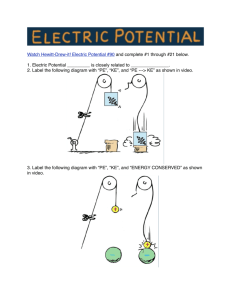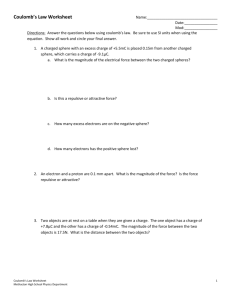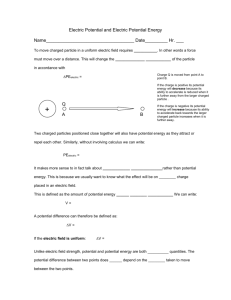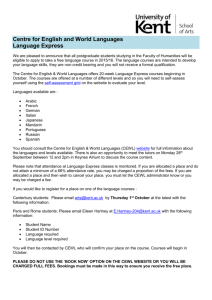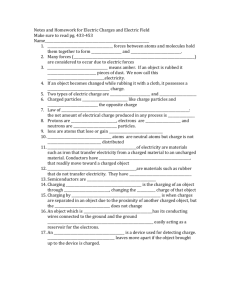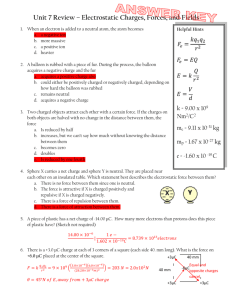17. EM field - Cloudfront.net
advertisement
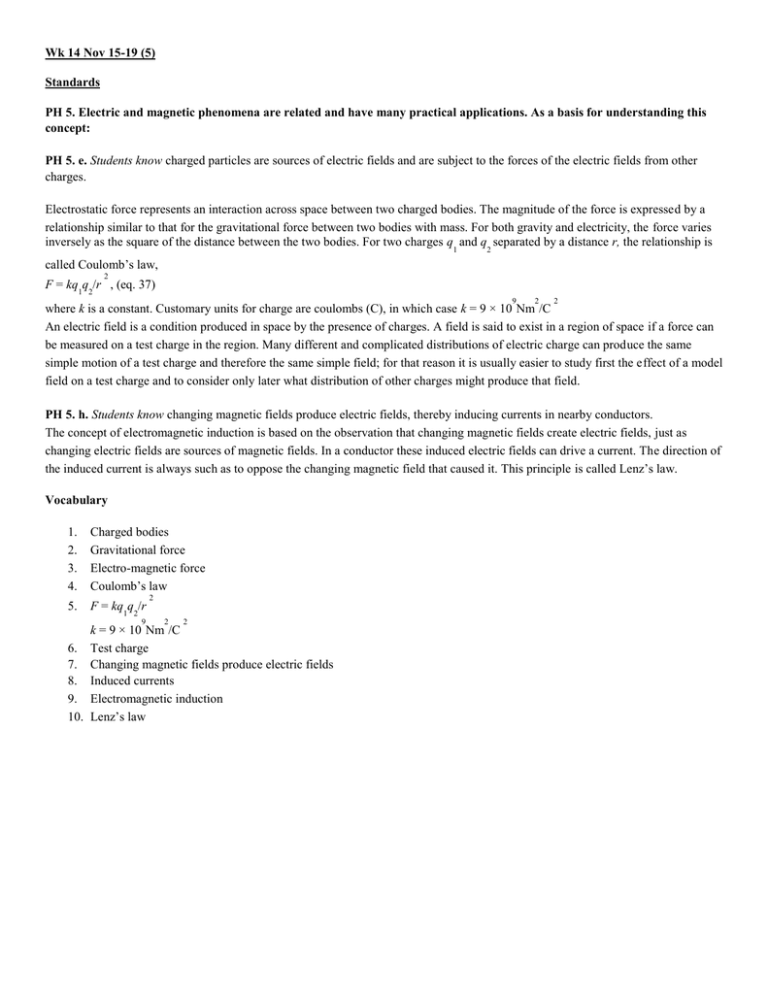
Wk 14 Nov 15-19 (5) Standards PH 5. Electric and magnetic phenomena are related and have many practical applications. As a basis for understanding this concept: PH 5. e. Students know charged particles are sources of electric fields and are subject to the forces of the electric fields from other charges. Electrostatic force represents an interaction across space between two charged bodies. The magnitude of the force is expressed by a relationship similar to that for the gravitational force between two bodies with mass. For both gravity and electricity, the force varies inversely as the square of the distance between the two bodies. For two charges q and q separated by a distance r, the relationship is 1 2 called Coulomb’s law, 2 F = kq q /r , (eq. 37) 1 2 9 2 2 where k is a constant. Customary units for charge are coulombs (C), in which case k = 9 × 10 Nm /C An electric field is a condition produced in space by the presence of charges. A field is said to exist in a region of space if a force can be measured on a test charge in the region. Many different and complicated distributions of electric charge can produce the same simple motion of a test charge and therefore the same simple field; for that reason it is usually easier to study first the effect of a model field on a test charge and to consider only later what distribution of other charges might produce that field. PH 5. h. Students know changing magnetic fields produce electric fields, thereby inducing currents in nearby conductors. The concept of electromagnetic induction is based on the observation that changing magnetic fields create electric fields, just as changing electric fields are sources of magnetic fields. In a conductor these induced electric fields can drive a current. The direction of the induced current is always such as to oppose the changing magnetic field that caused it. This principle is called Lenz’s law. Vocabulary 1. 2. 3. 4. Charged bodies Gravitational force Electro-magnetic force Coulomb’s law 5. F = kq q /r 2 1 2 9 2 2 k = 9 × 10 Nm /C 6. Test charge 7. Changing magnetic fields produce electric fields 8. Induced currents 9. Electromagnetic induction 10. Lenz’s law Standards Reading questions Write & Answer 1. Do charged particles produce an electric field? 2. Are charged particles subject to the forces of the electric fields from other charges? 3. What does the Electrostatic force represent? 4. What relationship is like the magnitude of the force? 5. What does the force inversely depend upon? 6. What does the force directly depend upon? (Give all three) 7. What is the relationship that gives force dependents? 8. What does k stand for? Give value. 9. What must be present to create an electric field? 10.A field is said to exist in a region of space if a _______ can be measured on test charge in the region. 11.Why is it easier to study first the effect of a model field on a test charge and to consider only later what distribution of other charges might produce that field? 12.Changing __________ produce electric fields. 13.What is based on the observation that changing magnetic fields create electric fields? 14.In a conductor these___________ electric fields can drive a current. 15.The direction of the induced current is always ________ the changing …(fill in the rest)_____________________________________________________________. Agenda M 11/15 None T 11/16 W 11/17 CST review CW PEQ Packet HW Vocab / Ch 5 Read w/Q’s Packet HandoutCoulomb’s law F eq. Ch 5 p.254-296 “Brochure” due Friday Packet WorksheetCoulombs Law Q’s Finish worksheet Due friday Qz R 11/18 Vocab / Read Review Packet Packet Study Handout woeksheet F 11/19 Test Name_______________ Per___ Grade__ Class_____ Assessments for Week___ Date______ Vocabulary Review 1. 2. 3. 4. 5. 6. 7. 8. 9. Charged bodies Gravitational force Electro-magnetic force Coulomb’s law 9 2 2 k = 9 × 10 Nm /C Test charge Induced currents Electromagnetic induction Lenz’s law a. Object with positive or negative net charge b. force between two masses 2 c. F = kq1q2/r d. Coulomb’s constant e. Charge used to detect an E-field ”q2” f. Observation that changing magnetic fields create electric fields, just as changing electric fields are sources of magnetic fields g. force between two charged bodies h. caused when a magnet moves in/out of coil and a coil moves around a magnet i. direction of the induced current is always such as to oppose the changing magnetic field that caused it Reading Review 1. 2. 3. 4. Do charged particles produce an electric field? What does the Electrostatic force represent? What does k stand for? Give value. What must be present to create an electric field? Work Sheet Wednesday Coulomb's Law Static Electricity Coulomb's Law can be states in equation form as F =k Q1 Q2 / d2 This equation can be used as an algebraic recipe for solving computational problems or as a guide to thinking about how an alteration in the quantity of charge or the distance between charged objects effects the amount of attractive or repulsive force. Using Coulomb's Law as a "Guide to Thinking" Alteration in the Quantity of Charge 1. Two charged objects have a repulsive force of .080 N. If the charge of one of the objects is doubled, then what is the new force? 2. Two charged objects have a repulsive force of .080 N. If the charge of both of the objects is doubled, then what is the new force? Alteration in the Distance between Charged Objects 3. Two charged objects have a repulsive force of .080 N. If the distance separating the objects is doubled, then what is the new force? 4. Two charged objects have a repulsive force of .080 N. If the distance separating the objects is tripled, then what is the new force? 5. Two charged objects have an attractive force of .080 N. If the distance separating the objects is quadrupled, then what is the new force? 6. Two charged objects have a repulsive force of .080 N. If the distance separating the objects is halved, then what is the new force? Alteration in both the Quantity of Charge and the Distance 7. Two charged objects have a repulsive force of .080 N. If the charge of one of the objects is doubled, and the distance separating the objects is doubled, then what is the new force? 8. Two charged objects have a repulsive force of .080 N. If the charge of both of the objects is doubled and the distance separating the objects is doubled, then what is the new force? 9. Two charged objects have an attractive force of .080 N. If the charge of one of the objects is increased by a factor of four, and the distance separating the objects is doubled, then what is the new force? 10. Two charged objects have an attractive force of .080 N. If the charge of one of the objects is tripled and the distance separating the objects is tripled, then what is the new force? Using Coulomb's Law as an "Algebraic Recipe" 11. A balloon with a charge of 4.0 x 10-5 C is held a distance of 0.10 m from a second balloon having the same charge. Calculate the magnitude of the repulsive force. PSYW 12. Calculate the electrical force (in Newtons) exerted between a 22-gram balloon with a charge of -2.6 μC and a wool sweater with a charge of +3.8 μC; the separation distance is 0.75 m. (NOTE: a μC or microCoulomb is a unit of charge; 106 μC = 1 C) PSYW 13. Suppose that two equally charged spheres attract each other with a force of -0.492 N ("-" means attractive) when placed a distance of 29.1 cm from each other. Determine the charge of the spheres. PSYW 14. A +5.0 μC charge and a -6.0 μC charge experience an attractive force of -0.72 N ("-" means attractive). Determine their separation distance. PSYW 15. A balloon has been rubbed with wool to give it a charge of -1.0 x 10-6 C. A plastic tube with a charge of +4.0 x 10-6 C is held a distance of 0.50 m above the balloon. Determine the electrical force of attraction between the tube and the balloon. PSYW 16. In the space at the right, construct a free-body diagram showing thedirection and the type of all forces acting upon the 30.0-gram balloon.Will the balloon accelerate up, down, or not at all? _____________If there is an acceleration, then calculate its value. (Assume that the plastic tube is held a constantdistance of 0.5 m from the balloon.) PSYW Name_____________________________ Per____ Grade___ Class ICS1 WK# 14 Date 11/15-19 Topic Physics 1. Title E-M 2. Objective 3. Overview 4. Standard Fields To understand the relationship between electricity, charged particles and magnetic fields. Electrostatic energy is considered a force. When you get Shocked you experience a force that is equal to the electrons involved and the distance between the two surfaces. I.e. the electron and your hand, or the electron and the TV When an electric field exists a magnetic field is present as well. Charged Particles in motion cause E-M fields to be present. PH 5. e. Students know charged particles are sources of electric fields and are subject to the forces of the electric fields from other charges. PH 5. h. Students know changing magnetic fields produce electric fields, thereby inducing currents in nearby conductors. 5. Analyzed Standard- (3-sentences) ____________________________________________________________________________________________________________ ____________________________________________________________________________________________________________ ____________________________________________________________________________________________________________ ____________________________________________________________________________________________________________ 6. Graphic Organizer- Creates Electric and Magnetic Field felt by test charge Charged Particle 7. Pivot Points- What you know as of Monday Protons in the nucleus are Positive (+) and Electrons “Clouding” the Nucleus are Negative (-). The polarity of the particle can be detected by a compass needle Current in a coil of wire creates both electric and magnetic fields that are perpendicular to the current and each other. The E-M field can be detected in the wire or outside the wire by a Test Charge and Coulomb’s Law Topic 1. Coulomb’s 2. E-M field 3. Coil of Wire 4. Compass Know …(Standards) 8. Inquiry Activity Developing Observation Skills: a. Give the features. 9. Interpreting Activity Developing Inferring Skills: a. What is given? Charge particle and e-fields Phet solution e-field patterns demo b. b. c. What can be reasoned? Describe the features. e-field goes down in all pic’s test charge changes direction based on charge type and if a force is given Uses in the scientific community. c. 9 2 How does doubling the distance increase the Force felt by the test charge, in the math skills Problem? 2 = (9 × 109 )(1.5 x 107 ) (2.0 x 108 ) N ___________________________________ (3.0 x 104)2 = (9.0)(1.5)(2.0) x 109+7+8 N ______________________ 9 x 104+4 9.0 x 108 N Describe the action and give reason 12. Critical Thinking ___________________________________ (3.0 x 104m)2 _____________ c. Understanding of e-field can give charge characteristics, current, magnitude, composition… F = (9 × 109 Nm2/C 2 )(1.5 x 107 C) (2.0 x 108 C) = 27.0 x 1024 What can you infer? What does this lead to? 2 k = 9 × 10 Nm /C q1 = 1.5 x 107 C q2 = 2.0 x 108 C r = 3.0 x 104 m b. Charge type influences e-field direction 11. Math Skills F = k q1q2/r 10. Exploration Activity Developing Analysis Skills: a. State observations? = 3.0 x 1016 N 13. Notes -tuesday Phet solutions Balloon and shirt demo Static increased hold negative charge Phet E_M field direction of E-field from charge positive charge: away negative charge: toward III. E-M fieldbattery or current in wire positive charge has a flow of electrons “away” negative charge has a flow of electrons “toward” adding electrons increase collision in a wire and increases “energy flow” current, because volume of the wire is constant IV. Coil of wire Electrons flowing around in circles in a wire cause E-M fields to be produced. The right hand rule can help tell the direction of each. I. II. Summary Same charge type –“push” Opposite charge type-“pull” Thursday On your own paper 14. Dispatch- The force of two charged particles is 1 x 106 N. If the charge of 1 is doubled, the charge of the other is tripled, and the distance between them is halved? 1 x 106 x (2) x (3) / (1/2)2 = ____ Following from a presentation on cd: use notes for help 15. Phet solutions Why did the balloon hold the negative charge? Static increased or decreased Why was the balloon pushed by the wall? Same or Opposite charge type Why was the balloon pulled by the Sweatshirt? Same or Opposite charge type 16. Phet E_M field What direction does the E-field point: a) from a positive charge: away or toward b) from a negative charge: away or toward ____ 17. E-M field “Remember the positive charge has a flow of electrons ____” Why did adding electrons increase the chance of a collision? 18. Pivot Points-Learned Topic 1. Coulomb’s 2. E-M field 3. Coil of Wire 4. Compass Learned… 19. Understanding and Applying Name _____________________________Period _____ Date ____________ handout Tuesday 1. F = k q1q2/r 9 2 2 k = 9 × 10 Nm /C q1 = 1.5 x 107 C q2 = 2.0 x 108 C r = 3.0 x 104 m 2 F= 3. 9 2 2 k = 9 × 10 Nm /C q1 = 2.0 x 10-3 C q2 = 2.0 x 108 C r = 3.0 x 102 m F= 5. 9 2 2 k = 9 × 10 Nm /C q1 = 5.0 x 10-2 C q2 = 1.0 x 10-1 C r = 3.0 x 1012 m F= 7. 9 2 2 k = 9 × 10 Nm /C q1 = 2.5 x 107 C q2 = 2.0 x 1010 C r = 3.0 x 104 m F= 2. 9 2 2 k = 9 × 10 Nm /C q1 = 5.0 x 10-3 C q2 = 2.0 x 108 C r = 9.0 x 102 m F= 4. 9 2 2 k = 9 × 10 Nm /C q1 = 0.5 x 102 C q2 = 6.0 x 109 C r = 3.0 x 10-2 m F= 6. 9 2 2 k = 9 × 10 Nm /C q1 = 4.0 x 105 C q2 = 2.0 x 102 C r = 8.0 x 105 m F= 8. 9 2 2 k = 9 × 10 Nm /C q1 = 2.0 x 101 C q2 = 2.0 x 101 C r = 6.0 x 104 m F=
